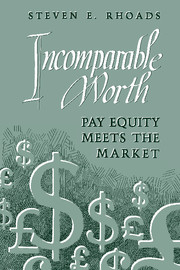Book contents
- Frontmatter
- Contents
- Acknowledgments
- 1 Introduction
- 2 The debate over equal pay for comparable worth
- 3 Implementing comparable worth in Minnesota
- 4 Job evaluation in Minnesota localities
- 5 Equal pay for work of equal value in the European Community
- 6 Equal pay for work of equal value in the United Kingdom
- 7 Equal pay for work of equal value in Australia
- 8 Conclusion
- Appendix: a note on the research and presentation of findings
- Notes
- Index
7 - Equal pay for work of equal value in Australia
Published online by Cambridge University Press: 06 July 2010
- Frontmatter
- Contents
- Acknowledgments
- 1 Introduction
- 2 The debate over equal pay for comparable worth
- 3 Implementing comparable worth in Minnesota
- 4 Job evaluation in Minnesota localities
- 5 Equal pay for work of equal value in the European Community
- 6 Equal pay for work of equal value in the United Kingdom
- 7 Equal pay for work of equal value in Australia
- 8 Conclusion
- Appendix: a note on the research and presentation of findings
- Notes
- Index
Summary
When discussing foreign experience with comparable worth, U.S. proponents turn most often to Australia. Without fail they draw on the work of Australian economist Robert Gregory and various coauthors. Gregory argues that Australian policy has significantly decreased the gap between women's and men's pay without disrupting the economy. Gregory's conclusions are based principally on his examinations of the impact of a 1969 decision of the Australian Conciliation and Arbitration Commission that granted women equal pay for equal work, and of the impact of a 1972 decision that phased in equal pay for work of equal value over a three-year period. By 1975 the pay of women relative to that of men had increased by almost 30 percent, and as Gregory and his colleagues see it, the negative effects were extremely small. In fact, some of their work suggests that negative effects were almost nonexistent. Comparable-worth proponents in the United States note that Australia applied the concept in a dramatic way throughout most of the economy and in a very short time. Since no “economic chaos” resulted, proponents wonder how critics can predict disaster from far more modest U.S. initiatives.
Though proponents treat Gregory's conclusions about comparableworth practice in Australia as gospel, they are disputed by other economists in Australia and the United States. Moreover, it is acknowledged on all sides that Australian economic performance over recent decades has been poor by most standard measures. A host of economic analysts have linked that poor performance to an unusual centralized wage-setting system, a system that made possible the rapid economywide introduction of large wage increases for female employees.
- Type
- Chapter
- Information
- Incomparable WorthPay Equity Meets the Market, pp. 179 - 217Publisher: Cambridge University PressPrint publication year: 1993



